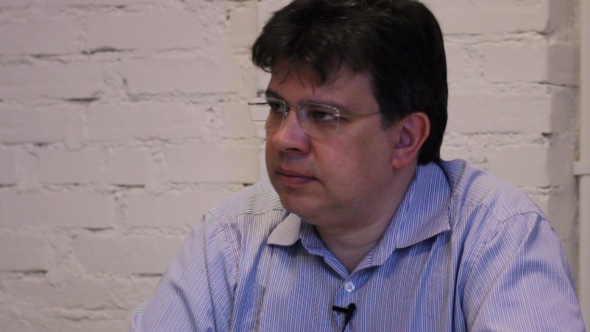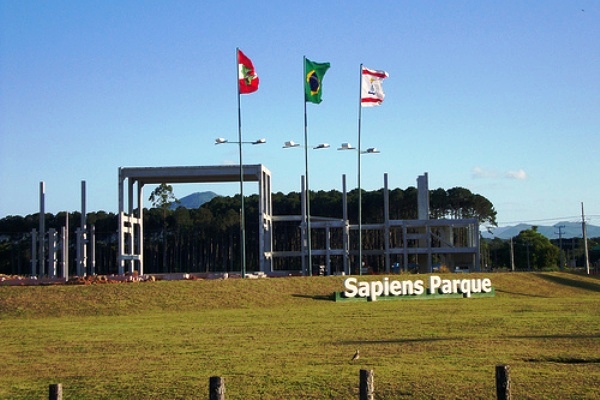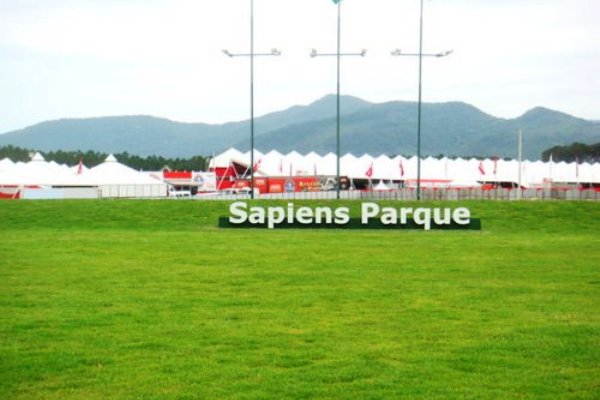Sapiens Parque: a Complex for Innovation, Science & Technology
Jose Eduardo Fiates, Executive Director of the innovation park Sapiens Parque, talks about the urban and environmental complex composed of scientific, technological, tourist, business and educational enterprises.
Interview with Jose Eduardo Fiates, Executive Director of Sapiens Parque

What innovation will Sapiens Parque bring to the area?
Our strategy portfolio and customer mix predicts that in the long term we should have about 50% of local firms, 30% of domestic and 20% of multinational companies with operations in Brazil.
The deferential innovative aspect of Sapiens is the way it integrates solutions that already exist in Brazil and in the world in the same specific systemic way. So, to look at it in practice: Florianopolis had a very strong growth process since the establishment of the Federal University around 1960. Twenty five years later the first Brazilian business incubator was created here in Florianopolis. Just like in the case of French incubators, a mechanism for support of the development of new businesses – mainly university start-ups – was created in Florianopolis. The growth strategy of the technology industry in Florianopolis was mostly based on local companies and internal growth. It was not by attracting companies from abroad; companies were born exactly as university research projects, developed with big companies which ended up creating opportunity for creation of new business to supply those companies. The incubator was created with this exact goal.
The incubator was created by an institution called Fundação Certi, which is a private non-profitable technology center. Such mechanism was already very common in Europe and the United States: the Institute Laroff in Germany, the Research Institute in France, England, etc. It was a model similar to what Europeans and Americans have operated here in Brazil. Today, Certi has 28 years of existence and 450 employees. It is already a success story, and in 1986 company incubators were created. The steps those companies were taking, forming and exiting of the incubator, demanded a proper site to settle indefinitely, and, a characteristic also typical and very developed in the countries of the northern hemisphere, technology companies have much intention and interest to stay together, close by for information exchange, cooperation on development projects, for cooperative businesses and other similar projects.
An action with ACATE, an association of technology companies in the region, was developed to create the first technological park. Thus, the first technological park was created in 1993, just 7 years after the creation of the incubator. It was a small park, just about 100,000 sq.m. with assigned space for 13 buildings. The incubator was transferred to this park and functioned for some time inside the building with ACATE, and today went on to operate in a permanent location, a building of 10,000 sq.m. where 40 companies are incubated and it already formed and graduated 75 companies. The technological park was completely occupied until the end of the 90s. In the beginning of the 21st century, Fundação Certi began again a process of interaction of various local entities, such as the university, ACATE, etc. to plan for a new park to receive the companies. And, here entered the innovation of Sapiens. We decided to not simply make a new technological park, but really do a job to develop a precedent that will represent a road for city development, an example of the strategy for the State and for Brazil itself, for the next 30-40 year, especially to take advantage that right now, Brazil is already leaning to a more sustainable growth and interest rate fall. We gathered a team of about 20 people. Fundação Certi contributed with architects, economists, marketing people, and people from the technology area, and we did a world benchmark in 26 countries: Denmark, Norway, Holland, Germany, France, England, Spain, Portugal, Italy, Taiwan, Korea, China, India, Japan, the United States, Canada, Israel, etc. In those 26 countries we identified and selected 300 projects but not just technology parks.

There was the first aspect that was particularly innovative: we surveyed cities, environmental projects, projects in clean energy, in culture, complex enterprise, commercial complexes, because the idea was no longer making a park but a species of innovative city. And that took to the creation of a concept that was effectively innovative at the time. It was in 2002, a technological park not like the one that existed, a concept of a science park in the Northern hemisphere in the 60s, but a park of innovation.
Sapiens Parque has the physical aspect; it is a place where we want to get organizations that generate knowledge and transform knowledge into results for society. The sector is not important. We are not limited to receiving companies of life science and information technology, but obviously we have our priorities. We have other scope, including that the park is focused on the service sector. Since Florianopolis is a tourist town we decided at the time that Sapiens should also be a springboard for the development of innovation for tourism in the city and this is also contemplated in the project. Also, Sapiens Parque was to represent a technological scientific enterprise of universities. The concept of a place for entrepreneurial and innovative initiatives was developed and it made sense for it to be a large space that would allow long-term growth and this is also an innovation in Brazil.
What is the difference between a technology park that existed before and the concept of innovation park?
Basically, the technology park within the traditional models that exist in Europe and the USA and already existed here in Brazil is quite restricted only to technology companies, as if it is a business district of technology companies. Here we believe in what we learned in Europe and the USA and so on, we got this mixture. You have to be increasingly competitive. Brazil will not want to be the best in electronics, because Korea and Taiwan already have hit the U.S. Not the best in Life Science, because France and Germany already are. Now in the integration of Life Science with mechatronics there are spaces that we can be competitive. In the integration of information technology with journalism there are new businesses. In the integration of art with interactive technologies we have spaces of competitiveness. Thus, putting in proximity different connection areas is the goal of Sapiens Park. This diversity is what some authors, like Richard Florida, call creative cities, where you put creative classes from various sectors together to create new businesses and new segments.
For that we need a large area, a large space that is something different here in Brazil, because, in general, we do not have right term projects, the designs are very immediate. So we decided that this case had to be a long-term project and identified this area. This is a prime area because it is entirely within the city, served by infrastructure and so on. It is 4.5 million square meters – larger than the entire city center of Florianopolis. That was a lengthy challenge. We had to make an entire planning process with the master plan to get license from an environmental point of view of the park master of the innovation plan. Today we are able to deploy 1,300,000 square meters of floor space. Potentially, we can have 250 building here in this park so it is effectively a small town.
Another element besides the conceptual aspect that makes a difference is the physical aspect. It is not common in Brazil to have a licensed park of this size, regularized with all environmental aspects resolved. We have created Sapiens Park Ltd. as a special purpose society. The proposed company’s specifics, as in the U.S. and Europe, allowed us at the same time to receive a land that was public, because the land was property of the state but the power commercialized it as a private enterprise. Until now we already commercialized more than 75,000 sq.m. of area for the business sector. It is different from other models that exist in Brazil and in the world where the land is owned by the Rent, or another precarious solution. At Sapiens, we managed an absolutely professional way to transfer ownership and do it with business models that allow financing, financial leverage and so on. Thus, Sapiens Parque has a model that is different from the sum of the various features that already operate in the world. We learned from the specific offer society that worked in certain places of the world, brought the models and applied here in projects that integrated art and technology, projects that integrated services and technology and tourism. We integrate all this in a new development in which, despite being at an initial deployment stage; we have terms of marketing companies including these various segments I mentioned.

So now you are at the marketing stage.
Yes. To give you an idea: in the last twelve months we sold or traded 70,000 sq.m. of area. It means that the buildings have begun to be constructed. Some are already under construction, which means approximately 3,500 to 4,000 people working in these buildings. Over the next 2 to 3 years, they will be completed. Sapiens Parque as a whole should have about 30,000 people working in its final stage. We have started the marketing stage. From the standpoint of launching the product in the market, it has an acceptance, we have passed that stage.
Is this step of communication linked or connected to local or international companies?
Our strategy portfolio and customer mix predicts that in the long term we should have about 50% of local firms, 30% of domestic firms and 20% of multinational companies with operations in Brazil. In the short term this chart is predominantly local and national because we are in the early development phase of the park. In 2013 – depending on the results we had last year and this year – we should already have a structure in order to take on a more formal role in seeking international companies.
What are the biggest challenges you are facing at the moment?
The major challenge that we all have here in Florianopolis is the same for the whole Brazil: we have to develop some large companies which will be highly successful in the area of Brazilian technology. If you are in other technological poles, this is a feature that Brazil must face.
How about Embrapa, Embraer?
We do not have a great digital company in Brazil or a large life sciences. In the area of energy, clean tech, we have beautiful industrial sector in conventional Vale do Rio Doce, Petrobras and so on, but these are not innovative but typical technology companies. Perhaps the most successful company in recent years has been Totus, which is a genuinely Brazilian company. Totus is working in the area of PR and competes with SAP. Nevertheless, there are still very few great technological companies.
The big challenge – related not only to us in Sapiens Parque but to the whole nation – is to manage to generate some large companies of national and international prominence. Specifically regarding the design challenges we have some short and medium term. The first is building the infrastructure of the park and developing its first buildings, so that you get a commercial credibility to the park itself, to spread and proliferate in a more intense way.
The second major challenge we have at Sapiens Parque is really developing the concept of cluster, i.e., make the companies actually have advantages of being close together, acting within a park, through technology partnerships, cooperative partnerships for marketing and business, including for internationalization in a cooperative manner. The development of the concept of cluster is something that comes from the beginning of the Sapiens’ project concept.
A third challenge we face, also not restricted to Sapiens: it is important to have mechanisms for financing investments and more agile, since funding from conventional banks to venture capital mainly to finance and facilitate the development of innovative business. It again is not only our particularity here in Sapiens Parque or in Santa Catarina but it relates to Brazil itself. Brazil is now beginning to draw attention of international funds, such as those that I will receive shortly, but also national funds which will start investing in productive activity due to the decrease in interest rates. Brazil is starting to have a more civilized interest rate, which will not leave alternative for those who have money to start investing a little more in the production area and not only in fixed income investments.
How do you see your medium-term development within 2 years? What do you want to achieve?
In our strategic planning that is already being followed in recent years – we have the milestones established as 2014 and 2020 – until the end of 2014 we should have roughly 5,000 people working in Sapiens Parque and already involved in the business activities that will mean something like 20 buildings. Not only companies, but also university research center, academics etc. That will represent one of the three largest technology parks in Brazil: today Sapiens is more or less in the top ten in terms of indicators with number of people working and businesses and things and such. But our goal is to get to the end of 2014 as one of the top three technology parks in Brazil, and by 2020 we want to be number 1. Our key indicators are the revenues of companies, number of people working in these companies and the number of square meters operating within the park.
Is there anything else you would like to say to conclude this interview?
Sapiens believes very much that this model of technological innovation is an important model for the development of the State. Santa Catarina is deploying technology parks also to serve as a strategy for boosting the economy and logic of effective integration between these parks and international integration. The relation of parks like ours with similar ventures in other countries is to be formed as a very structured network in a few years. It has not really matured yet even in other countries, e.g. in France – Sophia Antipolis, Montpellier, Paris, Grenoble, Nancy. There is not yet a business integration, it is still a very local thing. It is time to have an international interaction with the park in the Silicon Valley and with China. But the trend is that increasingly much of it will create a network of spaces for innovation, not necessarily just for parks. In some cases large business complexes will be more concentrated areas of innovation which have a strong relationship locally, nationally and doing business internationally, making technology cooperation and so on. Now in Rio+20 it was discussed widely that the countries failed to reach an agreement, but the larger cities have managed to establish cooperative networks, in regions such as Catalonia, southern France or the Bavarian region. We believe that this micro-regionality is reaching the level of the city and tends to increasingly become a concept of network structure and Sapiens is tuned with this strategy.